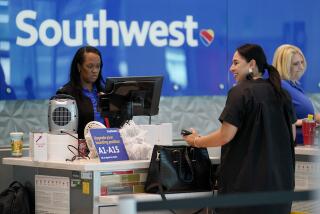VIEWPOINTS : 1987: Looking Ahead to a Year of Big Changes : Rise in Air Fares
- Share via
In 1987, you’re likely to see big changes in just about everything you buy. If you’re planning a vacation, you’ll notice differences whether you drive or travel by air. If you want to buy a home, you’ll be watching prices and mortgage rates closely. Eating out? You’ll see some unusual, new menus. The worlds of entertainment and retailing are in a state of upheaval. And, with a new tax law, investing may be more tricky than ever.
The Times polled experts in eight fields for their outlook on what 1987 will mean for businesses and consumers.
In the past year or a little more, large U.S. airlines have experienced more mergers and acquisitions than at any other time in history. Unusually strong price competition coincided with these moves and, as a result, the airline passenger found average fares dropping nearly 6% in 1986.
At the same time, the U.S. economy performed moderately well. With the large drop in average fares and a good economy, commercial air travel jumped nearly 10%, at times as much as 15% to 20%.
Since most of the moves to consolidate have already been made, it is highly likely that the degree of price competition will abate in 1987. With another year of moderate growth in the economy, airline fares should rise an average of about 1% in 1987. This must be viewed against the expectation that the U.S. overall inflation rate should go up between 3% and 4%.
The airline passenger can also expect some changes in service levels in 1987. We have already seen a reduction in departures at Minneapolis/St. Paul, St. Louis and Denver because of mergers. We can also expect increasing problems of congestion--and thus more en route delays for passengers--particularly at the eight or 10 largest U.S. airports.
Still, even with fewer carriers, there remains a high degree of scheduling competition among large airlines seeking to obtain and hold their share of the market. Large carriers now have 43 hub operations at 31 U.S. airports. They will continue to push for scheduling convenience for all passengers.
The continuing move to consolidate and merge will probably decrease the number of large carriers--now nine. This consolidation will place about 90% of the market in the hands of six to eight airlines, with 20 to 25 others holding the remaining 10%.
The result will be more stability in the industry and probably more predictability. Some of those signs are already here. Next year will be the fifth consecutive year of profitability in the industry.
Thus, 1987 will essentially complete the transition for the airlines from a large number of competitors to a relative few, fares will rise nominally but not above general inflation in the U.S. economy, travel will continue at a relatively high level--for an increase of nearly 7%--and consumer problems will exist primarily in delays at the airport and in the air lanes.
More to Read
Inside the business of entertainment
The Wide Shot brings you news, analysis and insights on everything from streaming wars to production — and what it all means for the future.
You may occasionally receive promotional content from the Los Angeles Times.










